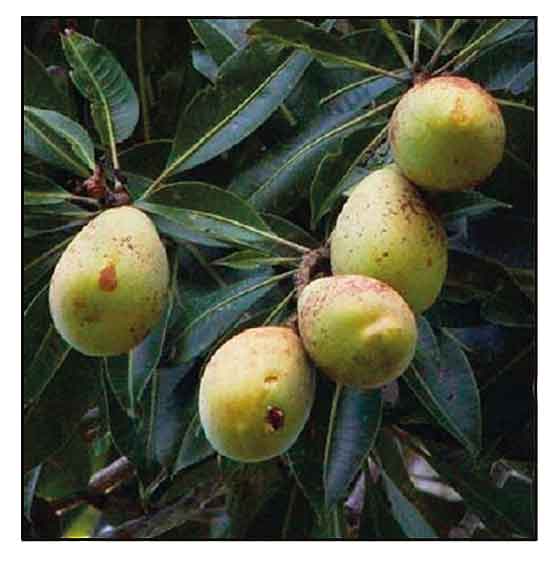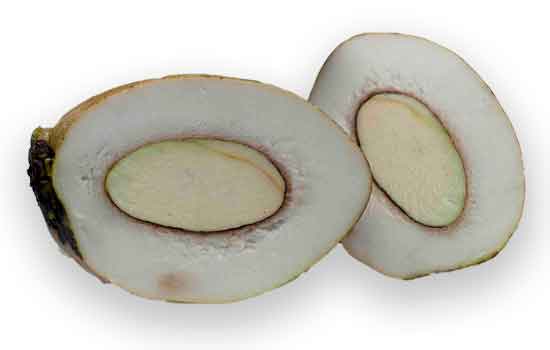 Gen info Gen info
- Mangifera cassia is a species of flowering plant in the cashew family, Anacardiaceae. It belongs to the same genus as the mango. (2)
- Species epithet caesia derives from Latin, meaning lavender color, referring to the color of the flowers.
Botany
Mangifera caesia is a large tree, often attaining majestic proportions, 30(- 45) m tall, and bole 50-80(-120) cm or more in diameter; bole columnar, without buttresses, crown dome-shaped with massive branches; bark grayish-brown, superficially fissured, containing irritant sap. Leaves elliptic to lanceolate, more or less obovate, (7-) 10-12(-30) cm x (3- )4-5.5
(-10) cm, medium green and shiny above, paler below, often crowded at the end of stout branchlets, coriaceous, blunt or bluntly acuminate; midrib thick, flattened, raised above, base gradually decurrent; petiole stout, flattened, 1-1.5(-2.5) cm long. Panicle terminal, 15-25(-40) cm long, much branched with stout rachis and branches, densely flowered, pale pink; flowers 5-merous, pale lilac, fragrant; petals linear, up to 10 mm long, not strongly reflexed as in most other mango flowers, only slightly reflexed in the upper part; fertile stamen 1, filament 5 mm long, white at base, purple towards the apex, 4 teeth-like staminodes; disc narrow, stipe-like, 1-1.5 mm long, pale green; ovary obliquely globose, reddish brown, style excentric, 8 mm long, white, becoming violet after anthesis. Fruit an obovate-oblong drupe, necked at base, 12-15(-20) cm x 6-7(-12) cm; skin yellowish or pale brownish, very thin (1 mm); pulp whitish, soft and juicy, fibrous, with a peculiar sourish taste and strong smell at maturity. The 'wani' form: fruit ellipsoid, rounded, 9-11 cm x 6.5-7 cm, glossy pale green at maturity, flesh milky white; the best forms are almost fiberless with a sweet pleasant taste; stone ellipsoid-lanceolate, ca. 7 cm x 3.5-4 cm, not flattened, thin-walled, endocarp not woody, made of matted coarse fibers, monoembryonic. (3)
 Mangifera caesia is a large tree, up to 45 m tall. Leaves are alternate, stalked, thick and leathery, about 7.5-41.5 cm long and 2.5-11 cm wide. Flowers are violet to lilac, up to 1 cm long each, borne on a branched inflorescences up to 40 cm long. Fruits are fleshy, pear-shaped drupes that ripen to pale brown, 10-19 cm long and 5-10 cm wide, containing a single pink seed enclosed with a hard endocarp. Mangifera caesia is a large tree, up to 45 m tall. Leaves are alternate, stalked, thick and leathery, about 7.5-41.5 cm long and 2.5-11 cm wide. Flowers are violet to lilac, up to 1 cm long each, borne on a branched inflorescences up to 40 cm long. Fruits are fleshy, pear-shaped drupes that ripen to pale brown, 10-19 cm long and 5-10 cm wide, containing a single pink seed enclosed with a hard endocarp.
Distribution
- Native (?) to the Philippines.
- Introduced into Borneo, Lesser Sunda Is., Maluku.
- Native to Malaya, Sumatera, Thailand.
- Restricted to wet lowlands below 450 m. Abundant in marshes and riverside areas.
Constituents
- Nutritional value of fruit per 100 grams: water 86.5 g, protein 1 g, fats 0.2 g, carbohydrat3s including fibers 11.9 g, ash 0.4 g, thiamine 0.08 mg, beta-carotene 0.005 mg, vitamin C 58 mg, total energy 200 kJ/100g. (2)
Properties
- Irritant: Sap of M. caesia can cause skin eruptions or dermatitis. White juice of immature fruit is irritating to the skin. (2)
- Studies have suggested antioxidant, antibacterial , mosquito larvicidal properties.
Parts used
Leaves.
Uses
Edibility
- Fruit is edible, fresh or cooked; preserved or pickled.
-
Eaten dipped in chili and soy sauce.
- Wild forms have sour fruits, but Borneo and Bali cultivars are sweet, fiberless, and tasty. (3)
Folkloric
- In Sabah, used to increase appetite, treat colds, body itching, high blood pressure and bronchitis.
- Leaves used to facilitate wound healing after tooth extraction.
(7)
 Studies Studies
• Flavonoids / Fruits: Study evaluated the flavonoid content in binjai leaf extract using ethanol and methanol solvents. Leaf flavonoids were classified as chalcone and auron. The methanol extract showed higher effectivity in blinding flavonoids compared to ethanol and n-hexane solvents attributed to differences in solvent polarities: 5.6 for methanol, 5.2 for ethanol, and 0.1 for h-hexane solvent. Results showed significant differences between ethanol and methanol groups. (4)
• Non-Cytotoxicity to Vero Cells / Leaves: Study evaluated whether Binjai leaves are cytotoxic to Vero cells. Eight concentrations from 1.25 µg/ml to 4000 µg/ml were used. Probit analysis showed IC50 of 2498.48 µg/mL (IC50 >1000 µg/mL constituted a non-toxic category). (5)
• Antioxidant / Leaves: Study evaluated the antioxidant activity of ethyl acetate fraction from 96% ethanol extract of binjai leaf. Based on IC50 parameters, the fraction of ethyl acetate in 96% ethanol extract produced very strong antioxidant activity (IC50 38.526 ppm with linearity of 0.999). The fraction yielded compounds namely: flavonoid, tannins, and phenols. (6) Study of of 96% ethanol extract of Binjai leaves obtained IC50Â (inhibitory concentration) as much of 16.14 ppm (very active); 70% ethanol extract, 37.94 ppm (very active); and 50% ethanol extract, 58.07 ppm (active). (7)
• Antibacterial against E. coli / Nanoemulsion vs Leaf Extract: Binjai contains polyphenolic compounds such as mangiferin, catechins, and epicatchins with antibacterial bioactivity. Study evaluated the antibacterial effect of plant extract by ethanol solvent maceration method and effect of a nanoemulsion formulation in facilitating its absorption. Results showed the inhibitory power of nanoemulsion on E. coli growth was less than that of binjai leaf extract, which may be to the low extract concentration of 5mg and 25 mg in the nanoemulsion. (8)
• Mosquito Larvicidal against Aedes aegypti / Essential Oil of Leaves: The essential oil of leaves of M caesia, M. casturi, and M. laurina exhibited larvicidal effect against A. aegypti. Study showed M. caesia and M. laurina could kill up to 100% larvae at concentration of 5000 ppm. Both species are known to contain saponins, tannins, phenolics, and flavonoids. Tannins are toxic to insects, binding to proteins in salivary glands and reduce activity of digestive enzymes. Saponins are detergent-like substances that damage the membrane, allowing toxic substances to enter the larvae body. The plant extracts have potential to be applied for integrated vector control. (9)
• Antimitotic Activity / Cytotoxic Potential / Fruit: Study evaluated the antimitotic potential of M. caesia. Allium cepa root was tested against aqueous (MCAE) and methanol (MCME) extract for 24 hours. MCAE at concentration of 6 mg/mL significantly (p=0.013) reduced the MI (mitotic index) of Allium cepa. MCAE at 5 mg/ml also had significant (p=0.009) reduction of MI of Allium cepa. Increase MI reduction with increase extract concentration suggest a dose dependent effect. Result indicate cytotoxic potential of both MCAE and MCME due to significant mitodepressive effect. The antimitotic activity suggests further sophisticated testing to determine anticancer potential. (10)
Availability
Wild-crafted.
|

![]()






